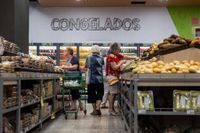Brazil's inflation rate showed signs of slowing down in April, with the National Consumer Price Index (IPCA) registering an increase of 0.43%. This figure, released on Friday, May 9, 2025, by the Brazilian Institute of Geography and Statistics (IBGE), marked a decrease from March's rate of 0.56% and was the highest for the month of April since 2023, when it reached 0.61%.
The April inflation data aligns closely with the median forecast of financial market projections, which estimated a rate of 0.42%, according to Bloomberg. The year-to-date inflation rate for 2025 now stands at 2.48%, while the IPCA accumulated over the past twelve months is 5.53%, surpassing the 5.48% recorded in the previous twelve months. This current rate is the highest since February 2023, when it was 5.6%.
Despite the slowdown in inflation, the IPCA remains significantly above the Central Bank's target ceiling of 4.5%. In response to rising prices, the Central Bank has implemented a series of interest rate hikes, with the Selic rate now at 14.75%, the highest level in nearly two decades. This strategy aims to cool down demand for goods and services, thus alleviating inflationary pressures. However, there are concerns that such measures could dampen economic activity, as borrowing costs rise for consumers and businesses.
The April inflation report revealed that the health and personal care sector recorded the most significant increase, with a rate of 1.18%. This was followed by clothing at 1.02% and food and beverages at 0.82%. Notably, while food inflation slowed compared to March's 1.17%, it still contributed significantly to the overall index, accounting for 0.18 percentage points of the monthly increase.
In the food category, the price of food at home rose by 0.83% in April, driven by sharp increases in the prices of potatoes (up 18.29%), tomatoes (up 14.32%), and ground coffee (up 4.48%). The latter has seen an astonishing 80.2% increase over the past twelve months, largely due to supply issues stemming from adverse weather conditions. Conversely, some food items experienced price declines, with carrots falling by 10.4%, rice by 4.19%, and fruits by 0.59%.
Health and personal care products also exerted considerable upward pressure on the index, influenced by pharmaceutical price increases that were authorized to rise by up to 5.09% starting March 31, 2025. The impact of these products was notable, contributing 0.08 percentage points to the IPCA.
On the transportation front, airfare prices dropped significantly, decreasing by 14.15%, which helped reduce the transport sector's overall inflation by 0.38%. This decline in transportation costs was also reflected in lower fuel prices, with reductions in diesel oil (down 1.27%), vehicular gas (down 0.91%), ethanol (down 0.82%), and gasoline (down 0.35%).
Economists are analyzing these inflation figures closely, as they indicate not only the resilience of economic activity but also the persistent pressure on monetary policy. The latest data points to a challenging inflationary environment, with core inflation rates remaining elevated. For instance, the average of core inflation measures rose by 0.50%, surprising many analysts who anticipated a decline.
Leonardo Costa, an economist at ASA, remarked that the IPCA demonstrates ongoing challenges, particularly with service inflation, which has remained high since December 2024, fluctuating between 7.5% and 8%. He noted, "This sluggishness in the inflation slowdown suggests that a robust labor market continues to drive aggregate demand."
Lucas Barbosa from AZ Quest highlighted unexpected price increases in food away from home, which rose by 0.80%, contradicting earlier expectations for a slowdown. He stated, "We anticipated a deceleration in food away from home, but instead, it has accelerated, alongside stronger numbers in automobile repairs, banking services, and personal grooming services. This acceleration was widespread across subcategories, as well as in industrial goods overall."
Despite the fluctuations, Gustavo Rostelato from Armor Capit indicated that the April IPCA figures do not alter overall inflation expectations. "Services remain at elevated levels, even with airfares showing deflation this month. Additionally, there was a notable surprise in industrial goods, driven by durable and semi-durable goods," he explained.
Looking ahead, the financial market anticipates a persistent inflationary environment, with projections for the IPCA at 5.53% by the end of 2025, as indicated in the most recent Focus bulletin released by the Central Bank. The market's expectations reflect concerns regarding the potential for continued inflationary pressures, particularly from services.
In light of these trends, analysts predict that the Selic rate may see another increase of 0.25 percentage points at the next Budget Policy Committee (Copom) meeting scheduled for June 18, 2025. This expectation is echoed by Igor Cadilhac from PicPay, who also forecasts the Selic will finish the year at 15%, with no cuts anticipated.
As the government navigates these economic challenges, it continues to celebrate positive data in other areas, such as GDP growth and declining unemployment rates. However, rising food prices remain a significant concern for President Lula and his administration, particularly as they disproportionately affect lower-income families and contribute to declining approval ratings.
In summary, Brazil's inflation landscape remains complex and challenging, with April's data underscoring both resilience in economic activity and persistent inflationary pressures. As the Central Bank continues to adjust its monetary policy in response to these dynamics, the coming months will be critical in shaping the country's economic outlook.




